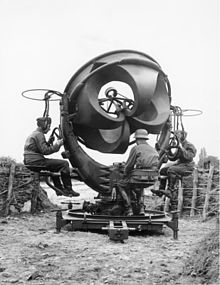Directional receiver
Listening devices were developed during World War I as a military reconnaissance device to locate artillery on the battlefield. They were still used during World War II to be able to locate enemy aircraft even in poor weather such as fog or darkness . However, with the increasing speed of aircraft and the invention of radar , the technology became largely obsolete.
A basic technical idea on which the listening device is based is continued today in the "acoustic camera" , albeit with a different technology and objective .
Directional hearers after Wertheimer and Hornbostel
The directional hearer is an apparatus for the acoustic localization of sound sources, which was developed by Max Wertheimer and Erich Moritz von Hornbostel at the Berlin Psychological Institute around 1915 for military reconnaissance .
With the advancing technical development of artillery , the battlefields in the First World War could hardly be overlooked. The military sound measurement system developed out of the need to find the enemy gun positions . One of the early purely acoustic devices was the directional receiver.
The directional receiver consists of two horns that are attached to a long rod, the base. The base is installed on a tripod and can be rotated. Sound tubes or tubes that are connected to the human ear are connected to the funnels .
The way it works is based on the very precise perception of the so-called central threshold. If a wave front of the sound does not hit both ears at exactly the same time, human perception can determine that there is a path difference. The accuracy increases with the distance between the ears. By using funnels on a long base, a virtual increase in distance is achieved. In order to localize a sound source, one rotates the base until this central perception occurs.
The directional receiver was registered for a patent in July 1915 . From 1916 he was regularly used for military reconnaissance. However, the successes were modest, because on the one hand artillery fire is only brief sound events, on the other hand there were several gun emplacements on the battlefields, so that localization was difficult.
During the First World War, Wertheimer tried to adapt the directional receiver for underwater applications, mainly in order to detect the screw noise of submarines . To this end, he carried out experiments in cooperation with the inspection of torpedoes . Due to technical difficulties, the project could not be implemented.
Ring funnel directional receiver
The directional receiver was much more suitable for localizing aircraft . The principle of the directional earphone was implemented in numerous devices that were used up until the 1930s - as ring horn directional earphones in the German Wehrmacht even until the end of World War II .
With the ring funnel directional receiver, four mechanically connected and crossed listening funnels were acoustically aligned with the sound source . By means of several devices, the true position of a sound source moving relatively slowly in the subsonic range could be determined via cross bearing .
The spatial alignment was carried out using stereo listening - acoustically via a tube without electronic amplification - by one person on each vertical and horizontal axis. The range of around five to twelve kilometers was very dependent on the prevailing weather conditions, the engine volume of the aircraft to be sighted, the background noise and the hearing ability of the person deployed. For all conscripts in flak units at the end of the 1930s, the acoustic hearing ability with regard to stereo hearing was measured to determine their suitability.
In August 1944, after a line-up by the Air Force Quartermaster General, Lieutenant General Dietrich von Criegern, 5559 ring funnel directional receivers were still in use.
Museum reception
A ring funnel directional receiver is exhibited in the military engineering study collection in the Langemarck barracks in Koblenz .
See also
literature
- Erich M. von Hornbostel, Max Wertheimer: About the perception of the direction of sound. In: Meeting reports of the Prussian Academy of Sciences. 1920, No. 20, 1920, ZDB -ID 211663-7 , pp. 388-396, ( digitized version ).
- Christoph Hoffmann: Science and the military: the Berlin psychological institute and the I. World War. In: History and Psychology. Volume 5, Issue 3/4, 1994, ISSN 0936-5338 , pp. 261–285.
- Werner Müller: Listening devices - command devices and searchlights of the heavy flak (= weapons arsenal. Special volume. 21). Podzun-Pallas, Friedberg / H. (Dorheim) 1991, ISBN 3-7909-0423-6 (Limited reprint: (= Waffen-Arsenal. Highlights. 12). Podzun-Pallas, Wölfersheim-Berstadt 2002, ISBN 3-7909-0766-9 ).
Web links
- Edgar Kutzscher: "Horchgeräte / Schallortung" - physical and technical basics of listening devices for aircraft noise, at www.Bunker-Dortmund.de, accessed on December 4, 2017
Individual evidence
- ↑ It all began in Berlin - Christa A Ossmann-Mausch
- ↑ For more information see: D. Brett King, Michael Wertheimer: Max Wertheimer & Gestalt Theory. Transaction Publishers, New Brunswick NJ et al. 2005, ISBN 0-7658-0258-9 , p. 121.
- ↑ Hornbostel and Wertheimer also presented a publication on this subject: Erich M. von Hornbostel, Max Wertheimer: About the perception of the direction of sound. In: Meeting reports of the Prussian Academy of Sciences. 1920, No. 20, 1920, pp. 388-396.


